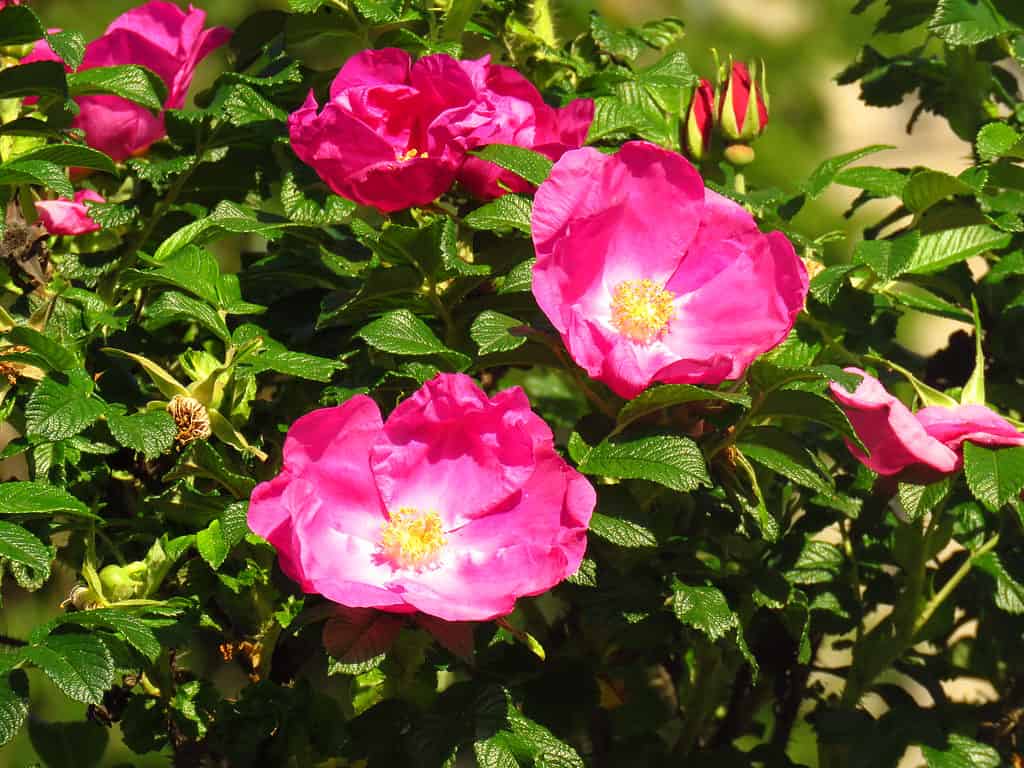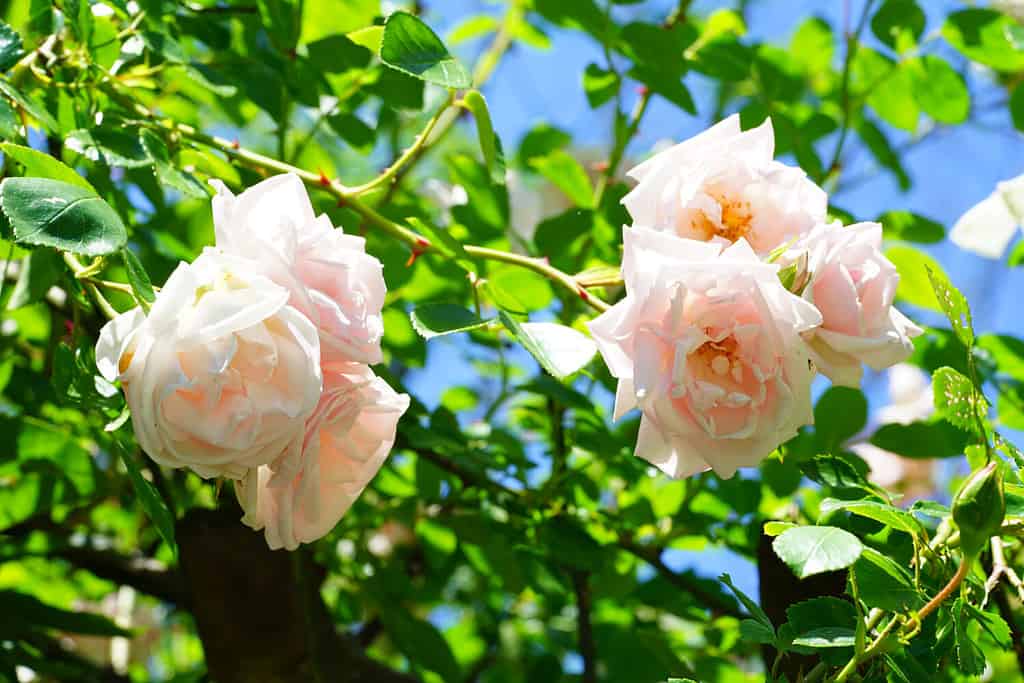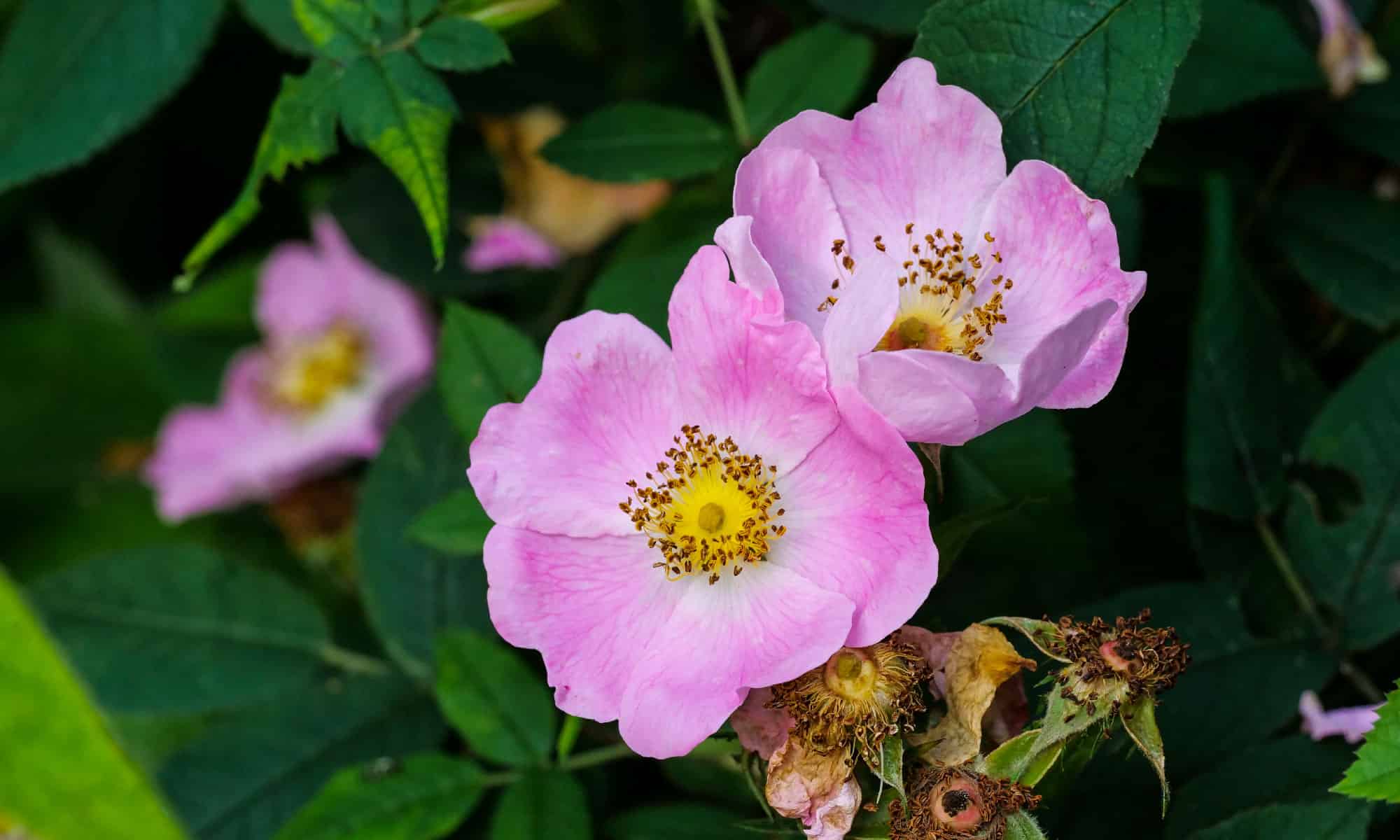Roses tend to do well in regions that have diverse climates, especially because there are so many varieties and cultivars out there that are designed to fit certain hardiness requirements. There are a ton of such roses that are well-suited for growing in the state of Pennsylvania. Let’s take a look at some roses in Pennsylvania that you can grow with ease!
1. Carolina Rose
Classification: Rosa carolina
One wonderful native wild rose with a lovely look and aroma is the Carolina Rose. It is indigenous to eastern North America, including Pennsylvania. It can be found in a variety of environments, including open woodlands, fields, and by the sides of roadways. This hardy rose variety has flourished in Pennsylvania’s arid environment and varied soils.
Usually a small to medium-sized shrub, the Carolina Rose can grow to a height of three to five feet. It has beautiful blooms with five petals that range in hue from light pink to white. The flowers’ delicious scent draws bees and butterflies, who serve as vital pollinators. The Carolina Rose’s aesthetic attractiveness is enhanced by the production of tiny crimson hips in the fall in addition to its blooms.
It’s crucial to pick a sunny spot with drained soil while growing Carolina Roses. They may survive in a variety of soil conditions, including sandy or clayey ones. Regular irrigation is advantageous, particularly during dry spells, but use caution not to overwater.
The Carolina Rose may be found growing in the wild all across Pennsylvania, although it is most common in open fields, meadows, and along the margins of forests. It is a lovely addition to naturalistic landscapes, cottage gardens, or native plant gardens. It is popular among gardeners who value native plants and wish to help the survival of nearby animal populations due to its hardiness, flexibility, and aesthetic qualities.

The Carolina Rose (pictured) is a great rose for attractive vital pollinators.
©Brookgardener/Shutterstock.com
2. Swamp Rose
Classification: Rosa palustris
The Swamp Rose is an alluring native wild rose that does best in damp or wet areas. It grows naturally in marshes, swamps, along stream banks, and low-lying places in eastern North America, including Pennsylvania. This lovely rose variety has beautifully adjusted to the particulars of its natural surroundings.
The Swamp Rose is a deciduous shrub with a maximum height of six feet. It has tasteful pink blooms that are solitary or semi-double and have a light scent. The flowers feature five petals, and in the middle, there is a large group of golden stamens. As they deteriorate, the petals progressively turn a lighter tint. In the fall, the Swamp Rose also produces small red hips which have a beautiful look all their own.
It’s crucial to mimic Swamp Roses’ ideal growth conditions if you want to grow these beauties in your own Pennsylvanian graden. They require damp to wet soil to grow, therefore finding a location with adequate drainage or next to a body of water is essential. For their development, full sun to moderate shade is excellent. To keep the soil wet, regular irrigation may be required, especially during dry spells. Mulching around the plant’s base can aid in moisture retention and prevent weed development.
The Swamp Rose grows in a variety of wetland habitats in Pennsylvania, including marshes, bogs, and the sides of streams and rivers. Any garden area that meets its moisture needs, including rain gardens and wetland restoration initiatives, benefits from this flower’s natural beauty. The Swamp Rose is a popular option for individuals interested in native plant landscaping because of its resistance to damp environments, elegant look, and fragrant blossoms.
3. Rugosa Rose
Classification: Rosa rugosa
A strong and resilient shrub rose, the Rugosa Rose enhances the beauty and allure of gardens and landscapes throughout New England. It is originally from eastern Asia, particularly in Japan, Korea, and China. However, it has spread around the world and even naturalized in some areas of Pennsylvania. The Rugosa Rose is widely known for its capacity to endure harsh growth circumstances.
The Rugosa Rose grows densely with lots of thorns, reaching an average height of four to six feet and spreading similarly broad. It has wonderful, wavy, dark green foliage that complements its eye-catching blooms beautifully. The flowers occur in pink, white, and even yellow hues and can be single or semi-double. Large, rounded hips that turn vivacious orange to red in the fall are another feature of Rugosa Roses that provide visual appeal.
Rugosa Roses are quite tolerant when it comes to cultivation and can endure a variety of soil types, including poor, sandy, or saline soils. They can take moderate shade but prefer the full sun. These roses are a low-maintenance option because of their remarkable disease resistance. During the establishing phase, regular watering is necessary, but after that, they can withstand drier circumstances.
The Rugosa Rose may be found in many places in Pennsylvania, including gardens all around the state and coastal regions. Due to their exceptional resistance to salt spray and severe winds, they are frequently used in coastal landscaping. Rugosa Roses are a well-liked option for individuals looking for a lovely and low-maintenance rose for their Pennsylvania gardens because of their remarkable hardiness, lovely flowers, and disease resistance.

Rugosa Roses (pictured) are very common in the wild across New England.
©Przemyslaw Muszynski/Shutterstock.com
4. William Baffin Roses
Classification: Rosa ‘William Baffin’
Beautiful climbing roses like the William Baffin Rose provide gardens and landscapes with height and beauty. It is a commonly grown cultivar that can flourish in the climate of Pennsylvania despite not being a native of the state. The William Baffin Rose was created in Canada and is named for the Canadian explorer William Baffin.
The robust growth and hardiness of this climbing rose make it appropriate for colder climes, including Pennsylvania. It has a maximum height of eight to 10 feet, making it quite tall for a rose. The William Baffin Rose has clusters of enormous, vivid pink, semi-double blooms. A strong contrast is made between the blossoms and the dark green foliage around them. Just as well, this variety has a slight fragrance.
The William Baffin Rose needs well-draining soil and does best in full sun to light shade when grown outdoors. Regular irrigation is beneficial for this variety, especially during dry spells. Since it is a climbing rose, this variety needs a trellis, fence, or pergola as support so that it can grow vertically.
The William Baffin Rose may be found in Pennsylvania’s gardens, parks, and arboretums. It is especially popular for its resistance to lower temperatures and is often used to provide landscapes with vertical coverage and brilliant color. The William Baffin Rose is a popular selection for Pennsylvania gardeners because of its robust growth, resilience to cold, and stunning pink blossoms.
5. New Dawn Rose
Classification: Rosa ‘New Dawn’
One well-known climbing rose known for its enduring beauty and dependable performance is the New Dawn Rose. It became a beloved classic in the rose industry after American rose grower Dr. Walter Van Fleet debuted it in 1930. Although not native roses in Pennsylvania, these outstanding hybrids can easily be grown there.
The exquisite, pale pink, semi-double flowers of New Dawn Roses have a delicate scent. A group of golden stamens can be seen in the center of the blossoms as they delicately unfold. The roses’s robust, thornless canes can grow as tall as 10 to 15 feet or more.
The New Dawn Rose loves well-drained, nutritious soil and does best when grown in full sun to light shade. It’s important to water often, especially when the weather is hot and dry. To direct its climbing growth behavior, a strong support structure like a trellis or moss pole is required.
The New Dawn Rose may be found all across Pennsylvania in gardens, parks, and private settings. Because of its tolerance to many climates, including that of Pennsylvania, it is a preferred option for climbing roses. The New Dawn Rose is a charming addition to any garden or landscape, providing an abundance of beautiful flowers throughout the growing season thanks to its timeless beauty, dependable performance, and thornless canes.

The New Dawn Rose (pictured) features fluffy, pale pink flowers.
©EQRoy/Shutterstock.com
6. Queen Elizabeth Rose
Classification: Rosa ‘Queen Elizabeth’
A traditional and opulent hybrid tea rose, the Queen Elizabeth Rose attracts attention with its stunning beauty. This well-known rose variety was developed in 1954 by Dr. Walter Lammerts. Although it is not indigenous to Pennsylvania, it may be cultivated there easily and is a popular choice among rose growers in the state.
The Queen Elizabeth Rose has enormous, fragrant flowers with a high center and an alluring combination of delicate pink hues. Each flower has about 35 petals, which together make a lovely cup shape. The flowers are perfect for cutting and putting in bouquets since they are supported by firm, long stems. The tiny blooms stand out sharply against the dark green leaves.
Pick a sunny spot with organically rich, well-draining soil if you want to grow the Queen Elizabeth Rose in Pennsylvania. The soil has to be watered often to be consistently damp, but excessive watering should be avoided. Mulch surrounding the bottom base of this rose provides additional moisture and prevents weed development.
The Queen Elizabeth Rose may be seen all across Pennsylvania in business areas, parks, and private gardens. The extraordinary beauty, scent, and exquisite shape of this rose make it a popular option for lovers of roses in general. The Queen Elizabeth Rose is a lovely addition to any Pennsylvania garden, providing a touch of regal beauty and sophistication. It has a timeless charm and the capacity to produce gorgeous flowers.

The Queen Elizabeth Rose (pictured) is an award-winning rose for its light scent and regal blossoms.
©iStock.com/yhelfman
7. Climbing Blaze Rose
Classification: Rosa ‘Climbing Blaze’
A striking and colorful climbing rose, the Climbing Blaze Rose delivers a blaze of color to gardens and landscapes. Dr. Walter Lammerts, an American rose breeder, first developed it in 1932.
The Climbing Blaze Rose is distinguished by its striking scarlet-red blossoms and creates a strong impression. The semi-double flowers include a group of golden stamens in the middle. These eye-catching blooms proliferate and cover the robust, thorny canes, which can grow to remarkable heights of eight to 12 feet or more.
Plant your Climbing Blaze Rose in a place that receives full sun to moderate shade in order to grow it successfully. It grows best on soil that has been improved with organic matter and is well-draining. Regular watering is essential to keep the soil hydrated, especially during dry spells. In order to direct and train the climbing canes, one should implement a trellis, arbor, or fence.
The Climbing Blaze Rose can be seen in gardens, parks, and private settings all around Pennsylvania. The Climbing Blaze Rose is a stunning addition to any Pennsylvania garden or landscape because of its eye-catching red flowers and robust growth.
Thank you for reading! Have some feedback for us? Contact the AZ Animals editorial team.








